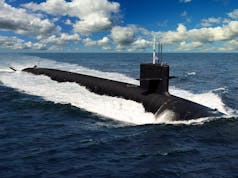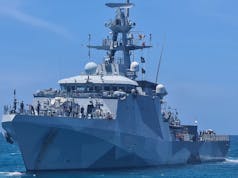Take a look inside the BAE shipbuilding halls as the first steel is cut for HMS Trent, a new offshore patrol vessel for the Royal Navy.
On the 6th of November 2013 it was announced that the Royal Navy had signed an Agreement in Principle to build three new OPVs based on the River class design at a fixed price of £348m including spares and support, an additional two vessels were outlined in the Strategic Defence & Security Review in 2015.
During a Defence Select Committee in July 2016, the First Sea Lord Admiral Sir Philip Andrew Jones indicated that the option for a fleet of ‘up to six’ offshore patrol vessels had been reduced to five, with Clyde being replaced by one of the new Batch 2 ships.
The First Sea Lord also elaborated on the potential uses for the Batch 2 ships overseas, including the possibility of forward basing an extra ship at the Falklands Islands, or forward basing it elsewhere. Admiral Sir Philip Jones said:
“Well, you are absolutely right that they have proved enormously useful, flexible and reliable ships. There are four vessels that we have in service at the moment. Three are Tyne, Mersey and Severn, which operate largely in UK waters on fishery protection and offshore tapestry protection, and of course they are increasingly working with the Border Force and the Maritime and Coastguard Agency in support of protection of UK waters. Then we have a fourth one, which is permanently based in the South Atlantic.
We have had those ships in service for quite some time now. We are looking at replacing them with slightly larger and more capable ships in due course anyway, so that was already in the course of production to bring three of those in. The additional two will enable us to take a longer term view of how we replace HMS Clyde, which is a slightly larger helicopter-capable version of the OPV. We are looking at a number of ways in which we might use the fifth one.
So, the fourth one is clearly a Clyde replacement.
The fifth one can either be added into the mix for the three that operate in UK waters or it could be forward-deployed somewhere else in the world, or it could become a second vessel operating in the South Atlantic. All those options are available.”
Pictured is ‘HMS Forth’ and one of her three sisters in an early stage of build.
Steel was cut on the 10th of October 2014 and they are expected to enter service starting 2017, with the last being delivered by the end of 2018.
The 90 metre OPV is based on a proven BAE Systems design which is already in service with the Brazilian Navy and Royal Thai Navy. BAE Systems have modified the design, ensuring it meets the requirements of the Royal Navy in support of UK interests both at home and abroad.
The programme has however been the focus widespread concern at the significantly increased cost of the Royal Navy variant.
The vessels will include a modified flight deck capable of operating Merlin helicopters, larger stores and more accommodation for embarked troops. They will also be the first ships to be built with a BAE Systems designed, new operating system called ‘Shared Infrastructure’, which will be rolled out across the Royal Navy surface fleet over the next ten years.
By replacing multiple large consoles dedicated to specific tasks with a single hardware solution, the amount of spares which are required to be carried on-board is reduced, significantly decreasing through-life costs.
The programme will sustain around 800 jobs on the Clyde and keep BAE yards ticking over over between work ending on new 70,600 tonne carrier HMS Prince of Wales and construction beginning on the first Type 26 frigates.
HMS Forth and her sisters will enter service from 2017.













nice ship but still underarmed
To be fair, all RN ships are underarmed not just the OPVs
Why would you build a 2000 ton ship which is nearly the size of the old Leander class frigate and put one 30mm gun for protection. Also OPVs will be globally deployable OH REALLY ??? with a Merlin Helo and no Hanger limted stores and they are expecting to send this class to the Falklands in winter.. with one 30MM Once again th UK Goverment has allowed BAE to build another load of Crap hand them over to Uk Border protection and protect Uk Waters .. Get some else to design ships for the Royal Navy not BAE. Someone wrote we should combine Fishery protection and Uk Border protection and Coast guard into one like to U.S
Forth is in the water. http://www.glasgowlive.co.uk/news/glasgow-news/watch-new-hms-forth-warship-11825899
What is “offshore tapestry protection?
If Brexit means regaining our UK fishing waters, then we will have a desperate need for these ships to stop the French and Spanish boats from poaching. They will not be encumbered by EU quotas when fishing in our waters, and will have every incentive to try to fish us out. Get building, lads!
I have collected data on the price of various Frigates, corvettes and OPVs. The figures are in millions of 2018 British Pounds.
Type 21: 176.5
Type 23: 268
Type 31: 250 (*)
iver huitfeldt: 263.6
Oliver Hazard Perry: 563.7
ANZAC frigate: 234
Khareef class: 133.3
Braunschweig-class: 427.2
River class: 116
Black Swan: 75 (*)
Samuel Beckett class: 63.9
Protector-class 84.7
Note that the River class is more expensive than any of the other OPVs listed. And it lacks the 3 inch gun of the Samuel Beckett class and the hangar of the Black Swan or Protector class.
I think the MOD policy of paying the shipyards whether they produce anything or not leads to cost increases, as the profit from actually making ships has to be large enough to cover the loss of the subsidy for idleness.
(*) projected price. None delivered.
I think that the RN should invest in black Swan sloops rather that River class OPVs. Basically a 4,000 ton ship with light armament, an over-sized hangar and a crane. It would serve two purposes: as an OPV, and when outfitted with a whole bunch of UAVs, UUVs and USVs as a mother-ship, operating under the protective umbrella of more capable warships.